|
|
|
|
July August Continues More Ramblings
August 1, 2000:
YEMEN: I've been in the
Yemen for three days now. Five days of walking around through
old San'a in absolute wonder. My arrival set the stage. My flight
from Cairo had been delayed and so I passed the time chatting
with some men from Saudi Arabia about their jobs working for
the big Saudi oil company AMOCO. Luck y for me that I ran into
these fellows though, because the airline I was flying, Yeminia,
doesn't quite cater to the non-Arabic speaker. Before I knew
what was going on the group was on its feet, out of the lobby
and heading for the plane, or what was posing as a plane. The
"new" fleet of 727s Yeminia was flying was a gift from
the Saudi government to Yemen in '98. I'm sure this plane was
made in the early 70s. When we loaded into the plane single file
through the tail I started to think that the Saudis "gift"
was just a clever war tactic. After crawling through the plane
up to my seat I plunked down and looked up to see a city-scape
of the traditional Yemeni tower house painted across the plastic
wall dividing the cattle from the first-class passengers.
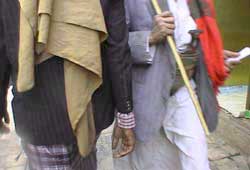
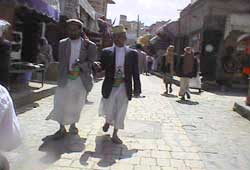
They
really really do live in mud sky-scrapers, I thought. "They
build just about everything out of mud in Yemen," said one
of the Saudis. "That's why we had to give them our planes!"
This was followed by loud snorting laughs from all seven of the
Saudi businessmen. It was late and I wasn't about to contemplate
mud airplanes seconds before take-off in a plane barely larger
than a tin can, so I smiled and buckled my seat belt.
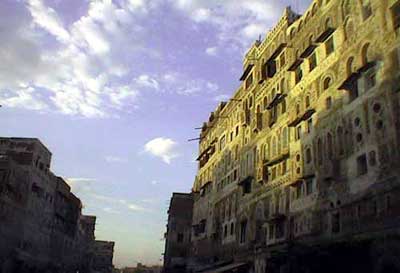
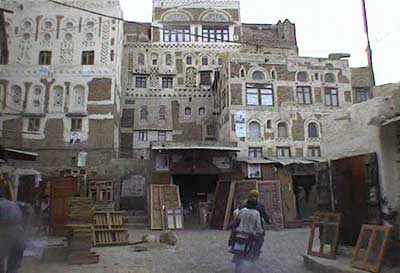
Surprisingly enough the flight was uneventful. We landed at
the small Sana'a airport and less than an hour later I was pulling
up to the front door of the AIYS (American Institute for Yemeni
Studies). As I stepped out of the Jeep the morning call to prayer
(sung rather than the usual recordings of other Muslim cities)
swelled up and over the city as the sun began to rise. It's usually
hard to define the exact moment when you fall in love, but at
that second I was instantly enamored with Sana'a. I followed
the driver and my backpack into a centuries-old tower house,
up five flights of stairs and into the apartment where I'd be
staying for the next two-weeks. If there is a heaven on Earth
than I had stepped into it. I put my bags down and walked into
the mafraj, or large sitting-room lined with pillows and
colorful stain-glass windows and looked out over the city. I
can't believe a place like this exists, I thought. And I
ducked out of the mafraj and through the narrow hallway
to the bed and passed out as the final shouts rang out from the
mosques.
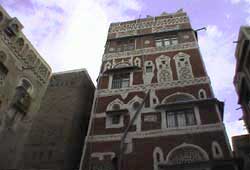
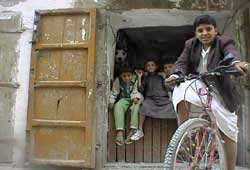
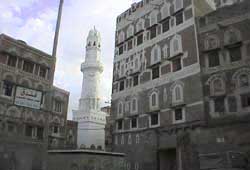
August 5, 2000:
Yesterday didn't start off any different from the previous
Yemen days. I woke up with the morning call to prayer (03:46,
03:50, 3:40, 3:33, in succession) and rolled out of bed to fire
up the stove for some tea. After a few hours of reading, I showered
and left the fonduk, a traditional Yemen house turned
hostel, and hopped into the first Jeep I saw in the road. (Actually,
the driver pulled even with me on the road and shouted "Wadi
Dhahr!", the place I happened to be heading.) Normally I
would trip to the old city of Sana'a to watch the Sana'anis wake
up. In the Jeep 15 minutes later I was surrounded by hundreds
of Yemenis, dressed in their Friday's best, most with a gun of
some sort slung around their shoulder. The reason I headed to
Wadi Dhahr was to see a part of the three-day wedding celebrations.
In Yemen weddings are a huge deal. Normally the mothers pick
out a wife for their sons and the husbands solidify the choice.
The bride will celebrate with the women of the two households
and the groom with the men. As is the common tradition in Yemen,
the new couple will not see each other until the final ceremony
when the bride lifts her veil.

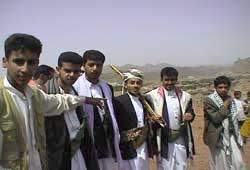
At Wadi Dhahr the men procession down the hillside surrounding
the groom. Some relatives fire their riffles into the air in
celebration, shells flying everywhere (handfuls of which found
their way into my pockets from the highly excited children).
At the bottom of the small hill overlooking the valley the men
begin to dance. A large circle is formed and the groom and several
of his relatives step into the middle and dance a wave their
jambias, a ten-inch, elaborately decorated dagger worn
on a belt around the waist, in the air.
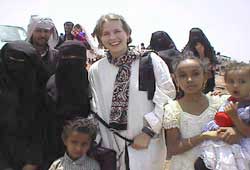
I walked around the hillside starring at all the fantastic
dancing, dodging shells and shell-giving children, and taking
pictures of all the men and boys who came up to me saying "Sura.
Sura. Photo.". One little boy grabbed my hand and lead me
up the hill to meet his mother. A group of five women, all heavily
draped in silky black fabric, said hello through the cloths covering
their faces, a small slit showing their eyes. Now, I don't speak
Arabic and these ladies didn't speak English but with squeezes
to my arms, giggles and a poor excuse for an English/Arabic dictionary
we were able to communicate. Ten-minutes later they loaded me
into the front of their pick-up and we were off. At the family's
home, a mud building two-stories high, I sat on pillows in the
diwan, first-floor living room, with the men and young
girls. I tried to help in the kitchen but the women wouldn't
have it. As far as they were concerned I belonged in the diwan
with the men.

The electricity went out and the sky poured fat rain on the
mud village, but the boys didn't care. They turned on the radio
and danced while poking fun of their grandfather because he had
no teeth. With candles lighting the center room the women called
us to come and eat. A huge spread covered the floor and in no
time at all the men had sat me down, showed me how to eat (right
hand scooping snowball-sized portions into the mouth), and with
a blink had finished their meal with a loud burp, a sign of approval.
The women then shooed the men back into the diwan making
sure I stayed put. And I ate again.
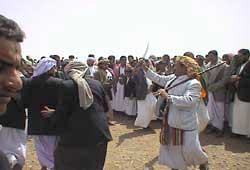
(The traditional second-day
wedding ceremony grounds. The grooms (holding sword in 1st row,
second) are accompanied by their male friends and family with
drums (1st row, first), while guns are fired (3rd row, first)
in celebration. The woman stand off and watch (2nd row) while
the men circle up and dance (3rd row, second) with their jambias,
the 10-inch long dagger worn around most Yemeni men's waists.)
After we were done, loud burps all around, they rolled me
off in the direction of the diwan. I plunked down and
was immediately handed a bag of qat, the mildly simulating
plant over 80% of the country chews at least once a week. I'd
heard many stories about the positive and negative effects of
qat, the latest being a report from the US stating "Non-narcatic.
Non-addictive." so I popped a branch into my mouth and started
masticating like a cow. The men smiled and showed me how to pluck
the leaves off the branch before shoving them into your cheek.
I didn't sit long in the diwan though because as soon
as the women were finished cleaning up they sat down with their
own stashes of qat, and they wanted me to sit with them.
An hour later, with some unseen gesture, it was obvious that
we were on the move. The women pulled me into another room and
donned their veils, slipped on their shoes. "Harem,"
they said, "The women." And we five ladies piled into
the truck to visit with 20 Yemeni women in a hot, hot diwan,
while ladies intermittently got up to dance.
Hours kind of slip by when you're animatedly trying to communicate
in a foreign language with roughage in your cheek, and before
I knew it the time was 8 o'clock. The large water-pipe was finished
and the qat was now making everyone quite and self-reflective.
I strapped on my shoes and waited for my friends to pull on their
cloaks.
Same time next week they said as we drove off. "Inshallah!"
I screamed, spitting bits of qat out onto the wet Sana'ani
streets.
|
|






